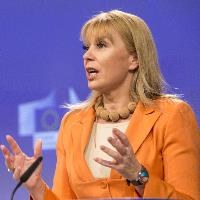(BRUSSELS) – The European Union outlined plans Wednesday to counter the growing threat to its security in the form of ‘hybrid’ threats, such as monitoring and countering illegal online content and propaganda.
Reporting on actions taken and next steps to implement the 2016 Joint Framework on countering hybrid threats, the Commission and the EU’s foreign policy chief Federica Mogherini said hybrid threats were an increasingly security concern for the EU, highlighting the need for an integrated approach to link internal resilience with the EU’s external actions.
“Cooperation in security and defence is not an option,” said Internal Market Commissioner Elzbieta Bienkowska, “it’s a must. Europe faces more hybrid, unconventional security challenges than ever. That is why, as the report shows, we are responding an unprecedented level of cooperation between the EU, Member States and NATO to improve resilience, address strategic vulnerabilities and prepare coordinated responses.”
The report shows ‘significant progress’ on each of the 22 actions to combat hybrid threats which were identified last year.
The EU has improved its awareness and the information exchange between Member States on these growing security threats, which often combine conventional and unconventional methods, ranging from terrorism and cyber-attacks to disinformation campaigns or media manipulation.
It has also made headway in protecting critical infrastructure in areas such as transport, energy, cybersecurity, and the financial system, as well as in counter violent extremism and radicalisation.
But more remains to be done, says the Commission, as the nature of hybrid threats continues to evolve. As part of the EU’s integrated approach to security and defence, the Joint Framework set out a number of actions to prevent, tackle and mitigate the growing challenge of hybrid threats. Work has been taken forward and progress has been made in all areas:
- Improving awareness: the EU Hybrid Fusion Cell was established in 2016, within the European External Action Service, to provide all-source analysis on hybrid threats. Separately, Finland has just launched the European Centre for Countering Hybrid Threats to encourage strategic dialogue and conduct research and analysis. In order to counter the widespread disinformation campaigns and systematic diffusion of fake news, Communication Task Forces for the Eastern and Southern Neighbourhoods have been established.
- Building Resilience: together with Member States, the Commission has been streamlining awareness on hybrid across sectors, including energy, transport, customs, space, health or finance. With he European Aviation Safety Agency, a Computer Emergency Response Team on Aviation and a Task Force on Cyber-security have been established. By the end of 2017, vulnerability indicators will be developed to help improve resilience of critical infrastructure. Technologies and priority capabilities required to counter and strengthen resilience against hybrid threats identified by Member States might be eligible for support under the recently proposed European Defence Fund.
- Protecting Europeans online: in line with the European Agenda on Security, the Commission has taken steps to reduce the availability of illegal content online. In particular the EU Internet Referral Unit established in Europol scans the web for online terrorist material. It has referred tens of thousands of posts to internet companies with on average 90% of these posts then removed. The EU Internet Forum launched in 2015 brings together governments, Europol and the biggest technology and social media companies to ensure that illegal content, including terrorist propaganda, is taken down as quickly as possible.
- Cooperation with third countries has been stepped up, to enhance their capacities and resilience in the security sector. A pilot project risk survey was launched with the cooperation of Moldova, aimed at identifying key vulnerabilities and to ensure EU assistance targeting specifically those areas.
- Preventing, responding to crisis and recovering: an EU operational protocol, the EU Playbook, has been developed which outlines the practical arrangements for coordination, intelligence collation, analysis, and cooperation with NATO. It will be tested through the PACE exercise (Parallel and Coordinated Exercise) in autumn 2017.
- EU-NATO cooperation: the EU and NATO established a common set of 42 proposals to implement the seven areas of cooperation identified in the Joint Declaration signed by President Tusk, President Juncker and Secretary-General Stoltenberg on EU-NATO partnership. Ten out of the 42 actions centre on countering hybrid threats, demonstrating the importance both sides pay to this issue. Interaction between the EU Fusion Cell and the NATO Hybrid Analysis Branch is an important element of EU/NATO cooperation on hybrid threats. For the first time, NATO and EU staff will exercise together their response to a hybrid scenario this year.
The EU says it will ‘continue to use all tools and instruments to address and react to potential hybrid threats, acting as a stronger and more responsive security provider, complementing actions by Member States and partners’.
Joint Framework on countering hybrid threats a European Union response


